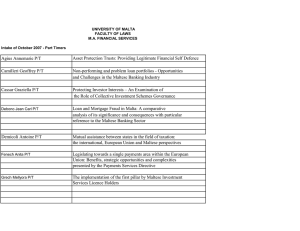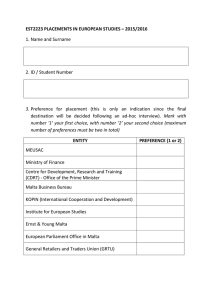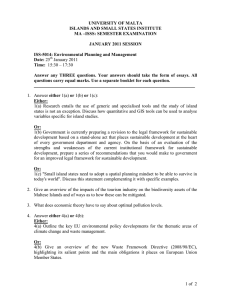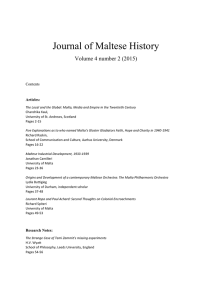Malta Journal of Health Sciences
advertisement
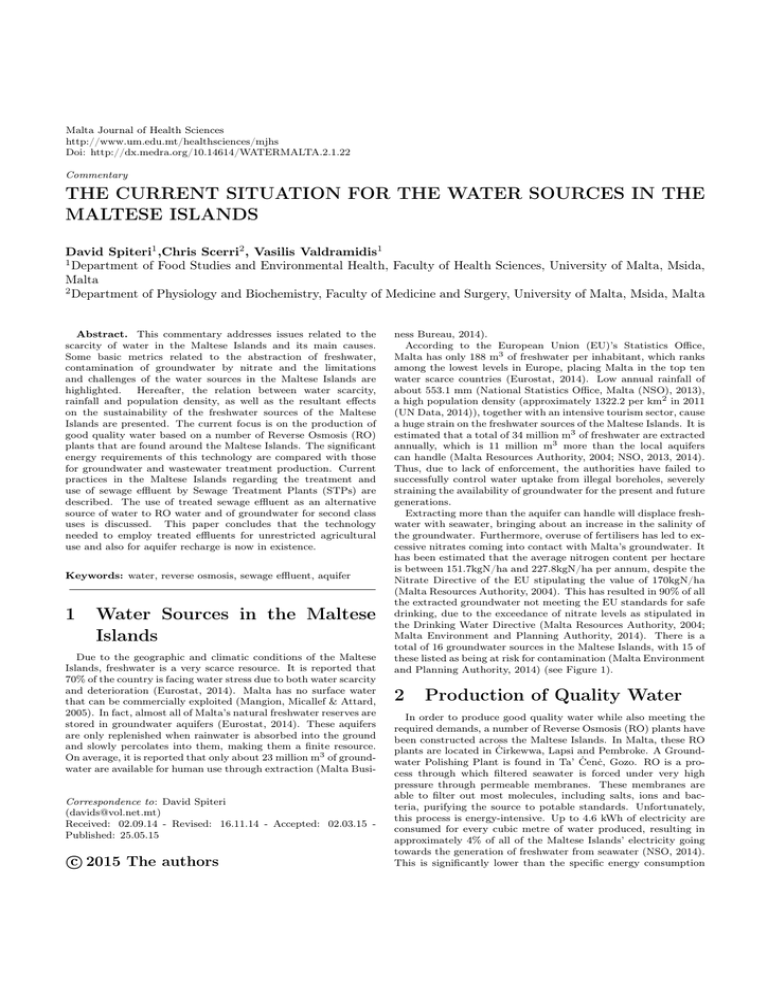
Malta Journal of Health Sciences http://www.um.edu.mt/healthsciences/mjhs Doi: http://dx.medra.org/10.14614/WATERMALTA.2.1.22 Commentary THE CURRENT SITUATION FOR THE WATER SOURCES IN THE MALTESE ISLANDS David Spiteri1 ,Chris Scerri2 , Vasilis Valdramidis1 Department of Food Studies and Environmental Health, Faculty of Health Sciences, University of Malta, Msida, Malta 2 Department of Physiology and Biochemistry, Faculty of Medicine and Surgery, University of Malta, Msida, Malta 1 Abstract. This commentary addresses issues related to the scarcity of water in the Maltese Islands and its main causes. Some basic metrics related to the abstraction of freshwater, contamination of groundwater by nitrate and the limitations and challenges of the water sources in the Maltese Islands are highlighted. Hereafter, the relation between water scarcity, rainfall and population density, as well as the resultant effects on the sustainability of the freshwater sources of the Maltese Islands are presented. The current focus is on the production of good quality water based on a number of Reverse Osmosis (RO) plants that are found around the Maltese Islands. The significant energy requirements of this technology are compared with those for groundwater and wastewater treatment production. Current practices in the Maltese Islands regarding the treatment and use of sewage effluent by Sewage Treatment Plants (STPs) are described. The use of treated sewage effluent as an alternative source of water to RO water and of groundwater for second class uses is discussed. This paper concludes that the technology needed to employ treated effluents for unrestricted agricultural use and also for aquifer recharge is now in existence. Keywords: water, reverse osmosis, sewage effluent, aquifer 1 Water Sources in the Maltese Islands Due to the geographic and climatic conditions of the Maltese Islands, freshwater is a very scarce resource. It is reported that 70% of the country is facing water stress due to both water scarcity and deterioration (Eurostat, 2014). Malta has no surface water that can be commercially exploited (Mangion, Micallef & Attard, 2005). In fact, almost all of Malta’s natural freshwater reserves are stored in groundwater aquifers (Eurostat, 2014). These aquifers are only replenished when rainwater is absorbed into the ground and slowly percolates into them, making them a finite resource. On average, it is reported that only about 23 million m3 of groundwater are available for human use through extraction (Malta Busi- Correspondence to: David Spiteri (davids@vol.net.mt) Received: 02.09.14 - Revised: 16.11.14 - Accepted: 02.03.15 Published: 25.05.15 c 2015 The authors ness Bureau, 2014). According to the European Union (EU)’s Statistics Office, Malta has only 188 m3 of freshwater per inhabitant, which ranks among the lowest levels in Europe, placing Malta in the top ten water scarce countries (Eurostat, 2014). Low annual rainfall of about 553.1 mm (National Statistics Office, Malta (NSO), 2013), a high population density (approximately 1322.2 per km2 in 2011 (UN Data, 2014)), together with an intensive tourism sector, cause a huge strain on the freshwater sources of the Maltese Islands. It is estimated that a total of 34 million m3 of freshwater are extracted annually, which is 11 million m3 more than the local aquifers can handle (Malta Resources Authority, 2004; NSO, 2013, 2014). Thus, due to lack of enforcement, the authorities have failed to successfully control water uptake from illegal boreholes, severely straining the availability of groundwater for the present and future generations. Extracting more than the aquifer can handle will displace freshwater with seawater, bringing about an increase in the salinity of the groundwater. Furthermore, overuse of fertilisers has led to excessive nitrates coming into contact with Malta’s groundwater. It has been estimated that the average nitrogen content per hectare is between 151.7kgN/ha and 227.8kgN/ha per annum, despite the Nitrate Directive of the EU stipulating the value of 170kgN/ha (Malta Resources Authority, 2004). This has resulted in 90% of all the extracted groundwater not meeting the EU standards for safe drinking, due to the exceedance of nitrate levels as stipulated in the Drinking Water Directive (Malta Resources Authority, 2004; Malta Environment and Planning Authority, 2014). There is a total of 16 groundwater sources in the Maltese Islands, with 15 of these listed as being at risk for contamination (Malta Environment and Planning Authority, 2014) (see Figure 1). 2 Production of Quality Water In order to produce good quality water while also meeting the required demands, a number of Reverse Osmosis (RO) plants have been constructed across the Maltese Islands. In Malta, these RO plants are located in Ċirkewwa, Lapsi and Pembroke. A Groundwater Polishing Plant is found in Ta’ Ċenċ, Gozo. RO is a process through which filtered seawater is forced under very high pressure through permeable membranes. These membranes are able to filter out most molecules, including salts, ions and bacteria, purifying the source to potable standards. Unfortunately, this process is energy-intensive. Up to 4.6 kWh of electricity are consumed for every cubic metre of water produced, resulting in approximately 4% of all of the Maltese Islands’ electricity going towards the generation of freshwater from seawater (NSO, 2014). This is significantly lower than the specific energy consumption The current situation for the water sources in the Maltese Islands Figure 1: Groundwater bodies found in the Maltese c Islands (Copyright 2014 Malta Resources Authority; reproduced with permission). in the mid-1990s, which was approximately 7.0 kWh/m3 , due to the greater amount of water produced to meet the demand. In comparison, the specific energy consumption for groundwater is 0.8kWh/m3 . For the production of treated effluent from municipal wastewater, the Sant’Antnin treatment plant in Marsascala, Malta, uses 1.3kWh/m3 (NSO, 2014). Figure 2 shows the electricity consumption of water production sources, with a lower trend emerging as investment in energy-efficient technologies, particularly in RO, proved successful. Therefore, it can be concluded that although RO plants are indispensible in meeting the potable water demand of the country, they cause a huge strain on the Maltese economy, while also increasing the national carbon footprint. Thus it is important to investigate the possibility of meeting part of the country’s water demand through less energy-intensive alternatives. 3 Water Management in Malta Between 2004 and 2013, 55.7% of all water utilised in Malta was produced by RO plants, while the other 44.3% came from groundwater sources (NSO, 2014). Over the years, governments have been trying to investigate trends in water consumption. In order to further illustrate water use in Malta, a report published by the Malta Resources Authority in 2004 indicated that the annual billed consumption was at 18 million m3 of water. However, the Water Services Corporation reported that the annual consumption exceeded 38 million m3 of water annually (Malta Resources Authority, 2004). This shows a huge discrepancy of 20 million m3 . There is currently no evidence on how this amount of water is utilised. It is important for farmers to have a good quality alternative to groundwater sources. The reuse of waste-water can be a good solution, as evidenced by the Moriso Project being implemented and researched by the Water Services Corporation (2013). Since 2004, the Water Services Corporation also became responsible for the collection, disposal and treatment of wastewater. Originally, only the Sant’Antnin plant existed. This is a treatment plant found in Marsascala, in the south of Malta, which has been in operation for the last 30 years. In 2009, it was reported to have treated about 2 million m3 of sewage, with half as much of the treated municipal waste going to agriculture and industry (Water Services Corporation, 2009). Approximately 75% of the treated water was used to irrigate 240 ha of land, while the remaining water was sold off to industry as second class water (Malta Resources http://dx.medra.org/10.14614/WATERMALTA.2.1.22 23 Authority, 2004). During the past 10 years, the Sant’Antnin plant produced on average 1.3 million m3 of irrigation effluent per year, that was used both in industry and agriculture, and 0.7 million m3 of unused irrigation effluent that was discharged into the sea (NSO, 2014). Unfortunately, a gradual decline in the demand for irrigation water produced by this plant was reported (NSO, 2014). This was probably due in part to a deterioration in the quality of the effluent because of increasing salinity, resulting from the lack of salinity reduction processes at the plant (Gauci, 1993; Mangion, 2000). The urban wastewater directive, 91/271/EEC, constrained EU countries to invest in the construction of several Sewage Treatment Plants (STPs) for treating sewage effluent before it is discharged into the sea. Nowadays, industrial scientists have been investigating ways of solving water shortage by safely utilising treated effluent as second class water. Currently, a total of four STPs are found in the Maltese Islands: Gozo STP, North STP, Ta’ Barkat STP in the south of Malta and Sant’Antnin STP, the latter meant to be decommissioned in due course. All of these STPs implement tertiary treatment of wastewater. Sant’Antnin STP, North STP and Gozo STP employ sand filtration followed by chlorination, while Ta’ Barkat, the newest STP, has facilities for sand filtration and UV treatment (United Nations Environment Programme, 2008). It is understood that all treated effluent produced by the North, Gozo and Ta’ Barkat treatment plants is released into the marine environment, and is not being used for agricultural or industrial purposes. 4 Operation of Sewage Treatment Plants (STPs) in the Maltese Islands As explained above, a number of STPs are found around the Maltese Islands. The Gozo STP, found in the limits of Mġarr ixXini, was built in 2007. During 2009, it treated approximately 4,000 m3 of sewage per day. The North STP, located in the limits of Mellie~a, started operations in 2008. It treats up to 8,200 m3 of raw sewage a day, before this is released into the sea through the marine sewage outfall. The Ta’ Barkat STP is capable of treating up to 60,000 m3 per day and treats around 80% of all the sewage produced in the Maltese Islands (United Nations Environment Programme, 2008; Water Services Corporation, 2009). This STP was the last to be built and utilises three main processes for water treatment, as described below. 4.1 Processing by a Sewage Treatment Plant (STP) Mechanical filtration is important to remove all the solid waste that may be found in the crude sewage. The heavier and bulkier solid waste is removed by mechanical grits, which resemble cages, in order for the solids to be removed and processed separately. The remaining fine particles, such as sand, are passed on to a secondary process, where a rotating machine removes the remainder of the particles. This is the part where the sewage is treated chemically in order to further bind any solid particles still present. The water is first treated with pH-stabilising chemicals in order to allow the sewage to become stable at around 7.5 to 8.5, in order to prevent the re-dissolving of certain precipitates, while also precipitating hydroxides of dissolved heavy metals. Next, ferric or aluminium (III) salts, followed by other synthetic polymer coagulants, are added in order to bind to the solid particles, which thus become heavier and sink to the bottom. This occurs in settling tanks, with the remaining solid material then treated as sludge. The sludge is treated separately and is used to produce 1 MW of power, which is in turn used to run the STP. The remaining water is passed on for biological treatment. As part of the secondary treatment, water http://www.um.edu.mt/healthsciences/mjhs The current situation for the water sources in the Maltese Islands 24 c Figure 2: Electricity consumption of water production sources (Copyright 2014 National Statistics Office, Malta (NSO); reproduced with permission). is allowed to settle in anaerobic conditions, where anaerobes act upon the nutrients found in the water and remove them by means of denitrification. Nitrogen gas is removed and then released in the environment. Following this process, water is passed into other tanks where blowers ‘foam’ it up, allowing aerobes to continue removing any organic waste. The STP then releases the treated effluent into the marine environment by means of underwater pipes beneath the thermocline. 5 Conclusions The Maltese Islands have always suffered from water scarcity and particularly during the last century, when the increasing population, irrigated agriculture and tourism placed enormous demands on the country’s limited resources. Although public water agencies have invested heavily in improving water production and distribution, exploitation of groundwater resources still reaches unprecedented levels. To date, treated sewage effluent has been under-utilised, despite the fact that the country has invested in treatment plants to treat all sewage. Technologies to make treated effluent useable are currently available on the market and may be considered as a means to produce polished effluent for agricultural use and for increasing recharge of the aquifers. 6 Funding This work was supported by a Malta Government Scholarship Scheme grant awarded to David Spiteri and by the University of Malta Research Fund (Grant DES/192/2014/46). 7 Conflicts of Interest The authors report no conflicts of interest. http://dx.medra.org/10.14614/WATERMALTA.2.1.22 References Eurostat (2014) Water statistics - statistics explained. [Online] Available from: http://http://ec.europa.eu/eurostat/ statistics-explained/index.php/Water_statistics. [Accessed 13th July 2014]. Gauci, V. (1993) Supply of irrigation water in a semi-arid area. In S. Busuttil, F. Lerin & L. Mizzi (Eds) Malta: Food, agriculture, fisheries and the environment (pp. 83-91). Montpellier: CIHEAM (Options Méditerranéennes: Série B; Etudes et Recherches, n. 7). Malta Business Bureau. Water scarcity [Online] Available from: http://www.investinginwater.org/Water+Scarcity/ Water+Scarcity/589 [Accessed 13th July 2014]. Malta Environment and Planning Authority (2014) Waters in Maltese Islands. [Online] Available from: http:// www.mepa.org.mt/topics-water-islands [Accessed 13th July 2014]. Malta Resources Authority (2004) Economic characterization of the Maltese water catchment district. [Online] Available from: http://mra.org.mt/wp-content/uploads/2012/08/6. economic_charcaterisation_FULL.pdf [Accessed 13th July 2014. Malta Resources Authority (2014) Groundwater bodies [Online] Available from: http://mra.org.mt/wp-content/uploads/ 2012/08/wfd-Groundwater-Bodies.pdf [Accessed 13th July 2014]. Mangion, M. (2000) Utilization of treated urban waste waters for irrigation purposes in the south of Malta. In N. Lamaddalena (Ed.) Proceedings of the Annual Meeting of the Mediterranean Network on Collective Irrigation Systems (CIS-Net) (pp.45-49). Bari: CIHEAM (Options Méditerranéennes: Série B; Etudes et Recherches, n. 31) Mangion, J., Micallef, P. & Attard, G. (2005) Treated sewage effluent - an alternative water supply for the Maltese islands. In A. Hamdy (Ed.) NonConventional Water Use: WASAMED project [Online] Available from: http://ressources.ciheam.org/om/pdf/b53/ 00800772.pdf [Accessed 9th June 2013]. http://www.um.edu.mt/healthsciences/mjhs The current situation for the water sources in the Maltese Islands 25 Mangion, J., Micallef, P. & Attard, G. (2005) Treated sewage effluent - an alternative water supply for the Maltese islands. In A. Hamdy (Ed.) NonConventional Water Use: WASAMED project [Online] Available from: http://ressources.ciheam.org/om/pdf/b53/ 00800772.pdf [Accessed 9th June 2013]. National Statistics Office, Malta (NSO) (2013) World Water Day 2013: International Year of Water Cooperation. NSO 056/2013. National Statistics Office, Malta (NSO) (2014) World Water Day 2014: Water and Energy. NSO 054/2014. United Nations Environment Programme (2008) Municipal wastewater treatment plants in Mediterranean coastal cities: inventory of treatment plants in cities of between 2,000 and 10,000 inhabitants. Mediterranean Action Plan for the Barcelona Convention Technical Reports, No. 169. UN Data (2014) Country profile - Malta. [Online] Available from: http://data.un.org/CountryProfile.aspx?crName= MALTA [Accessed 20th July 2014]. Water Services Corporation (2009) Water operations. [Online] Available from: http://www.wsc.com.mt/sites/default/ files/annual-report-09_-_wastewater_operations_unit. pdf [Accessed 15th November 2014]. Water Services Corporation (2013) Moriso Project Inauguration [Online] Available from: http://www.wsc.com.mt/content/ moriso-project-inauguration [Accessed 15th November 2014]. http://dx.medra.org/10.14614/WATERMALTA.2.1.22 http://www.um.edu.mt/healthsciences/mjhs


